思普云工业互联网平台v1.7.1版操作手册
平台使用手册说明书

平台使用手册2020年7月目录1.文档概述 (1)1.1.编写目的 (1)1.2.浏览器推荐 (1)2.操作说明 (1)2.1.平台注册 (2)2.2.平台登录 (3)2.3.选课——课程中心 (4)2.4.选班——网络班级 (8)2.5.个人中心——学习 (11)2.5.1.我的课程 (11)2.5.2.我的网络班级 (13)2.5.3.课程在线学习 (15)2.5.4.我的证书 (26)2.5.5.调查问卷 (27)2.6.个人中心——动态 (28)2.7.个人中心——消息 (29)2.7.1.通知公告 (29)2.8.个人设置 (30)2.8.1.个人基本信息修改 (30)2.8.2.更换头像 (31)2.8.3.密码修改 (32)1.文档概述1.1.编写目的本手册旨在为国家卫生健康委干部培训中心远程教育培训平台学员提供关于系统的使用说明和注意事项,以使各位学员可以更高效、安全的在平台中进行操作及查询等。
1.2.浏览器推荐为了能更好的访问平台,建议您使用谷歌浏览器、360浏览器极速模式、极速浏览器极速模板等谷歌内核浏览器。
2.操作说明学员在浏览器下输入地址:/cms/,即可打开网站门户页面。
通过该门户系统可以查看管理员发布的新闻公告、培训通知等内容。
同时还可以通过门户系统查看报名管理员推荐的课程资源以及培训班级资源等。
除此之外,还可以在该门户页面中登录到学员工作室,进行在线课程学习,交流互动,如果没有相应账号可以通过点击“注册”按钮,在线立即完成账号注册,账号注册无须管理员审核。
2.1.平台注册点击门户页面的上方的注册按钮,进入到以下注册页面。
根据页面提示输入相应内容,点击注册。
注册成功后,无须管理员审核直接生效。
点击登录,输入用户名密码进行登录操作即可。
2.2.平台登录在用户登录区内输入用户名、密码、验证码,点击登录按钮,即可完成登录操作,登录后显示该学员报名的课程、班级数据,点击“进入个人中心”可跳转到个人工作室。
云宽带操作手册
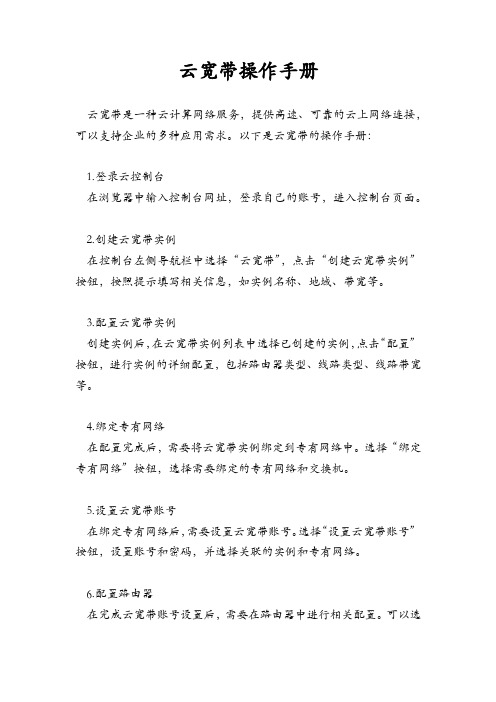
云宽带操作手册
云宽带是一种云计算网络服务,提供高速、可靠的云上网络连接,可以支持企业的多种应用需求。
以下是云宽带的操作手册:
1.登录云控制台
在浏览器中输入控制台网址,登录自己的账号,进入控制台页面。
2.创建云宽带实例
在控制台左侧导航栏中选择“云宽带”,点击“创建云宽带实例”按钮,按照提示填写相关信息,如实例名称、地域、带宽等。
3.配置云宽带实例
创建实例后,在云宽带实例列表中选择已创建的实例,点击“配置”按钮,进行实例的详细配置,包括路由器类型、线路类型、线路带宽等。
4.绑定专有网络
在配置完成后,需要将云宽带实例绑定到专有网络中。
选择“绑定专有网络”按钮,选择需要绑定的专有网络和交换机。
5.设置云宽带账号
在绑定专有网络后,需要设置云宽带账号。
选择“设置云宽带账号”按钮,设置账号和密码,并选择关联的实例和专有网络。
6.配置路由器
在完成云宽带账号设置后,需要在路由器中进行相关配置。
可以选
择手动配置或使用阿里云提供的自动配置工具。
7.测试连接
在完成以上操作后,可以对云宽带进行测试连接。
从本地网络中ping云端服务器地址,确认云宽带是否正常连接。
通过以上步骤,可以完成云宽带的创建和配置,实现企业在云上的网络连接需求。
云平台操作手册
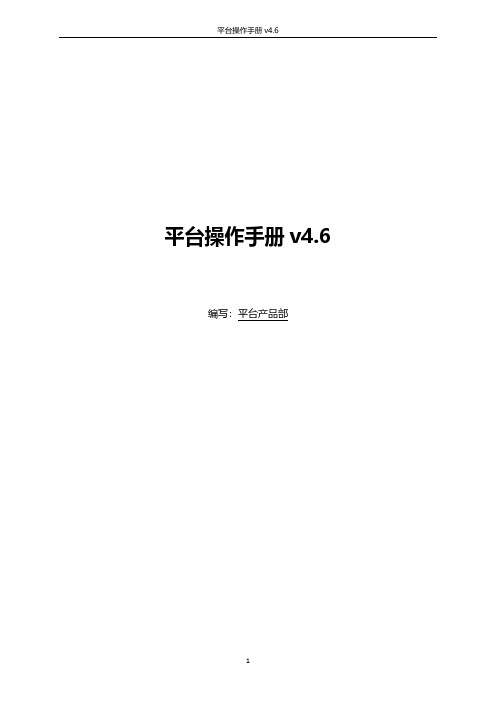
平台操作手册v4.6编写:平台产品部目录+一、概述 (12)一、官网小程序 (14)1.选择行业 (14)2.概览 (14)3.店铺管理 (15)3.1.模板市场 (15)3.2.装修店铺 (16)3.3.小程序跳转 (24)3.4.微页面 (25)3.5.图片库 (28)3.6.个人中心 (30)3.7.地址管理 (31)3.8.支付方式 (32)3.9.连接WIFI (33)3.10.链接公众号图文 (35)3.11.分享 (35)4.客户管理 (36)4.1.客户管理 (36)4.2.用户表单 (37)4.3.会员管理 (39)二、电商小程序 (42)1.商品管理 (42)1.1.商品管理 (42)1.3.商品分组 (46)1.4.运费模板 (47)如何设置合适的运费模板? (49)1.5.商品规格 (52)2.订单管理 (54)2.1.所有订单 (54)2.2.订单详情 (56)2.3.订单设置 (56)2.4.订单评论 (59)2.5.运单设置 (62)3.商城店铺装修 (64)三、外卖零售小程序 (67)1.外卖商品管理 (67)1.1.外卖商品管理 (67)1.2.新建外卖商品 (68)1.3.商品分组 (71)1.4.店铺配置 (71)1.5.小票打印机 (73)1.6.位置管理 (74)1.7.商品规格 (75)1.8.配送管理 (76)1.9.补充信息 (77)2.外卖订单管理 (84)2.1.所有外卖订单 (84)2.2.订单详情 (85)3.外卖店铺装修 (85)四、预约小程序 (86)1.预约商品管理 (86)1.1.预约商品管理 (86)1.2.新建预约商品 (86)1.3.商品分组 (89)2.预约订单管理 (90)2.1.所有预约订单 (90)2.2.订单详情 (91)3.预约店铺装修 (92)五、营销插件 (92)1.优惠券 (93)1.1.优惠券管理 (93)1.2.新建优惠券 (94)2.全民拼团 (96)2.1.全民拼团管理 (96)2.2.新建全民拼团 (97)2.3.全民拼团订单 (98)3.疯狂砍价 (99)3.2.新建疯狂砍价 (100)3.3.疯狂砍价订单 (101)4.秒杀活动 (102)4.1.秒杀活动管理 (102)4.2.新建秒杀活动 (102)4.3.秒杀活动订单 (104)5.新版拼团 (104)5.1.新版拼团活动管理 (104)5.2.新建活动 (106)5.3.新版拼团订单 (108)6.大转盘 (108)6.1.大转盘活动管理 (108)6.2.新建大转盘活动 (109)6.3.大转盘中奖名单 (112)7.口令红包 (112)7.1.设置口令红包 (112)8.摇钱树 (114)8.1.摇钱树活动管理 (114)8.2.新建摇钱树活动 (115)8.3.摇钱树中奖名单 (117)9.砸金蛋 (117)9.2.新建砸金蛋活动 (119)9.3.砸金蛋中奖名单 (121)10.心跳对对碰 (122)10.1.心跳对对碰活动管理 (122)10.2.新建心跳对对碰活动 (123)10.3.心跳对对碰中奖名单 (127)11.咻一咻 (127)11.1.咻一咻活动管理 (127)11.2.新建咻一咻活动 (128)11.3.咻一咻中奖名单 (132)12.刮刮卡 (133)12.1.刮刮卡活动管理 (133)12.2.新建刮刮卡活动 (134)13.当面付 (137)13.1.当面付收款码管理 (137)13.2.新建收款码 (138)13.3.当面付订单 (140)14.会员卡 (141)14.1.会员卡管理 (141)14.2.新建会员卡 (142)14.3.会员管理 (143)15.积分 (145)15.1.积分规则 (145)15.2.积分明细 (146)16.会员储值 (147)16.1.会员储值 (147)16.2.新建储值项目 (147)16.3.储值概况 (148)16.4.收支记录 (148)17.会员次卡 (149)17.1.会员次卡 (149)17.2.收入概况 (151)17.3.次卡核销 (152)17.4.核销方法 (152)18.社区管理 (154)18.1.版块管理 (154)18.2.新建版块 (155)18.3.话题管理 (156)18.4.新建话题 (158)18.5.话题详情 (158)18.6.话题分类 (158)18.7.用户管理 (160)19.满包邮 (160)20.满减 (161)21.商品推广 (162)22.支付推广 (162)23.营销活动管理 (164)六、多门店管理 (165)1.总店 (165)1.1.子店列表 (165)1.2.新建子店 (167)1.3.店铺分类 (168)1.4.多门店组件 (168)1.5.订单管理 (169)1.6.收益管理 (171)1.7.提现管理 (172)2.子店 (173)3.多门店规则 (174)七、分销管理 (174)1.分销系统定义 (174)2.分销管理 (175)2.1.分销开关 (176)2.2.推广员准入条件 (176)2.3.分销佣金 (179)2.4.推广海报 (179)2.5.佣金结算 (180)2.6.支付佣金 (180)3.推广员管理 (180)4.推广员分组 (181)5.佣金管理 (183)6.数据统计 (183)八、小程序发布 (184)1.注册小程序 (184)1.1.注册小程序 (184)1.2.完善小程序信息 (184)1.3.微信支付(无需线上支付功能跳过该章节) (185)1.3.1.申请微信支付 (185)1.3.2.获取微信支付参数 (186)2.小程序发布 (187)2.1.在线上传 (187)2.1.1.授权绑定 (188)2.1.2.支付参数配置(不涉及线上支付可跳转本章节) (189)2.1.3.在线更新打包 (190)2.1.4.提交审核/发布 (190)2.2.代码包下载 (191)2.2.1.配置小程序参数 (191)2.2.2.配置小程序服务器域名 (192)2.2.3.支付参数配置(不涉及线上支付可跳转本章节) (193)2.2.4.下载代码包 (194)2.2.5.安装微信小程序开发者工具 (195)2.2.6.导入小程序代码包并上传 (196)2.2.7.预览并提交审核 (198)3.注意事项 (199)九、其他 (200)1.数据管理 (200)1.1.概况趋势 (200)1.2.地区分布 (200)1.3.用户统计 (201)1.4.数据助手 (201)2.平台设置 (202)2.1.模板消息 (202)2.2.短信通知 (203)2.3.修改密码 (205)2.4.页面路径 (205)2.5.权限账号 (206)2.6.核销员管理 (208)2.7.开放API (210)3.资产管理 (212)3.1.收支流水 (212)3.2.对账单 (212)3.3.套餐管理 (212)一、概述本手册主要对有小程序商城后台各行业功能的使用进行说明,便于商家使用及管理自己的一、官网小程序1.选择行业登录后台后,先进入行业选择界面⏹官网小程序:适用于小程序品牌传播、咨询展示等场景⏹商城小程序:适用于小程序在线开店、客户管理等场景⏹外卖零售小程序:适用于小程序餐饮、水果、零售、便利店等场景⏹预约小程序:适用于小程序预约服务、上门到店等场景平台客户需要根据自身场景选择搭建对应的小程序2.概览选择官网小程序后,会进入概览页面⏹核心数据:展示小程序的核心概要数据⏹常用功能:后台常用功能快捷入口,一键即可进入对应功能⏹数据趋势:展示小程序的最近7天的数据概要趋势⏹精美店铺推荐:最新的客户案例展示⏹客服&帮助中心:可以向客服咨询或者自行查看平台使用帮助3.店铺管理3.1.模板市场进入“店铺”——模板市场,可以根据自身行业或者使用场景挑选合适的小程序模板快速搭建自己的小程序。
协同管理平台安装指导手册
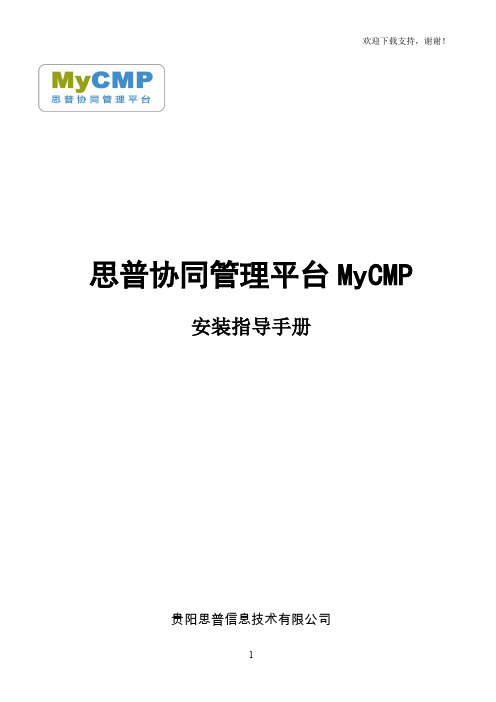
欢迎下载支持,谢谢!思普协同管理平台MyCMP安装指导手册贵阳思普信息技术有限公司一、MyCMP系统程序的安装介绍▲注意 MyCMP系统部分功能需要java环境支持,建议安装附带的jdk6程序!(1)请打开安装光盘或解压缩后的文件目录,双击执行“Setup.exe”或“MyCMP-标准版BuildXXXX.exe”程序,进入以下页面:显示出页面后请点击【下一步】按钮:(2)如对许可协议没有异议,请选择“我同意”后点击【下一步】按钮:如上图所示,本步骤是设置数据库的连接参数,请根据实际情况填写,如不清楚请首先询问贵单位的计算机系统管理人员,另外也可以致电思普公司咨询。
(3)填写完成点击【下一步】按钮:▲注意 MyCMP系统内部已经使用8080端口,这里设置请勿填写8080端口!如上图所示,本步骤用于设置MyCMP系统的安装目录及Web服务程序的响应端口,根据实际需要进行填写,若系统中已经安装了IIS等Web服务程序,请不要填写和IIS使用的端口相同的端口号,以免造成端口冲突。
(4)填写完成后点击【下一步】按钮:确认上面所设置的参数完全正确后,请点击【下一步】按钮开始文件安装:随后会弹出如下图所示的解压文件的窗口,该窗口不能手动关闭,安装完成后它会自动关闭,否则会无法完成安装MyCMP:(5)至此安装完成,点击【完成】后系统会自动启动服务,并运行MyCMP服务管理器程序:系统批处理程序首次运行后会出现以上错误,这不影响系统使用,点击确定即可,下次再启动批处理程序就不会出现该错误的。
出现类似于上面的页面时,点击ok按钮即可,这是在给操作系统安装MyCMP服务。
二、MyCMP服务管理器的操作介绍MyCMP系统安装程序运行完毕之后会自动弹出【MyCMP思普服务管理器】程序,也可通过桌面上的快捷菜单点击进入程序,【MyCMP思普服务管理器】的页面如下图所示:数据库操作打开服务管理器程序后默认进入【数据库操作】的功能页面,包括数据库登录的参数设置和数据库服务状态信息:(1)数据库地址:Sql Server服务器地址,一般情况下本机为服务器请填写127.0.0.1或localhost;如果采用了数据和程序分离结构,请填写Sql Server服务器的IP地址。
思普云1.71版本操作手册英文版SuperCloud Operation Manual1.7.1
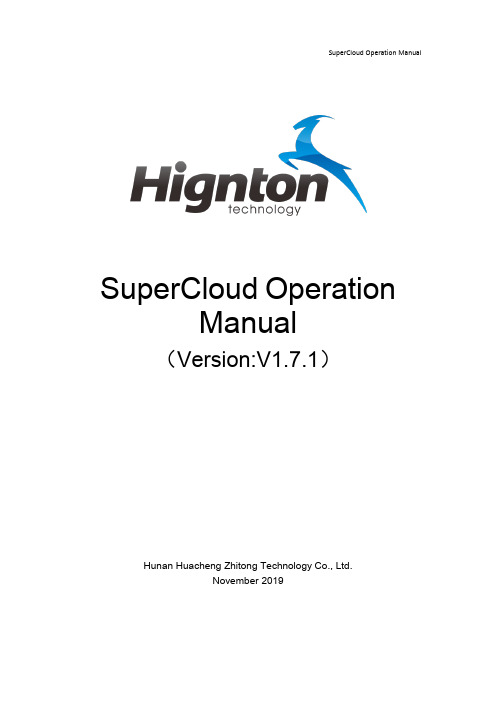
SuperCloud OperationManual(Version:V1.7.1)Hunan Huacheng Zhitong Technology Co., Ltd.November 2019catalogue1.Introduction (1)1.1.Purpose of writing (1)1.2.Background of the project (1)1.2.1.Development of Industrial Internet of Things (1)1.2.2.Development needs of the Industrial Internet of Things (2)1.2.3.Significance of the Industrial Internet of Things (2)1.3.References (3)2.SuperCloud Console operation guide (3)2.1.SuperCloud Address (3)2.2.Log in (3)2.3.System Overview (4)2.4.Product Equipment (6)2.4.1.Product Management (7)2.4.2.Device Management (12)2.5.Gateway Management (15)2.5.1.Gateway Configuration (15)2.6.Configuration Management (18)2.6.1.Standby configuration (18)2.6.2.Production line configuration (24)2.7.Video Management (25)2.8.Fault Management (28)2.8.1.Parameter settings (28)2.9.Maintenance Project (29)2.10.Gang Control (31)2.10.1.Linkage Rule (31)2.10.2.Add rules (31)2.10.3.Control Log (32)2.11.Message notification (32)2.11.1.Message notification setting (32)2.11.2.Message sending record (35)2.12.SMS management (36)2.12.1.Purchase of recharge (36)2.13.Space management (37)2.14.Internet of things card management (38)2.15.Knowledge Classification (39)2.16.System Management (40)er Management (41)2.16.2.Role Management (43)2.16.3.Operation log (45)2.16.4.System Setup (45)3.SuperCloud Big Data Center Operations Guide (46)3.1.GIS map (47)3.2.Real time protection (48)3.2.1.Real-time data (48)3.2.2.Real-time configuration (50)3.2.3.Real-time video (50)3.3.Maintenance Center (51)3.3.1.Historical fault (51)3.3.2.Maintenance notice (52)3.3.3.Work Order Management (53)3.4.Historical Data (62)3.4.1.Data display (62)3.4.2. DA (63)3.5.KBM (65)3.6.Telecontrol (67)3.7.Remote programming (70)4.SuperCloud APP (71)4.1.Download APP (71)4.2.Login APP (74)4.3.APP function module (74)4.3.1.Equipment (74)4.3.2.Production line (83)4.3.3.Maintenance and protection (84)4.3.4.News (86)4.3.5.Mine (87)SuperCloud Operation Manual1.IntroductionSuperCloud Platform is a management cloud platform developed by Hunan Huachen Zhitong Technology Co., Ltd.SP Industrial Cloud Platform focuses on effectiveness,Feature-rich,Simple and efficient operation,Beautiful and elegant interface.Each functional module is clear,Support user-defined permission management and page configuration,User operation is more efficient, convenient and flexible.Monitor equipment and data in real time0,Provides parametric graphs and live video,Send equipment fault alarms in real time.1.1.Purpose of writingThis operation manual is for reference of the operator of SuperCloud,Explain to users how to operate the SuperCloud Platform.1.2.Background of the project1.2.1. Development of Industrial Internet of ThingsIndustrial IoT promotes industrial transformation and upgrading.With the rapid development of the Internet of Things technology, a series of national strategies such as Made in China 2025, the US Advanced Manufacturing Partnership Program, and German Industry 4.0 have been proposed and implemented. Under this background, the Industrial Internet of Things has emerged as the times require, and it has become an intelligent change in the global industrial system Important promoter. The Industrial Internet of Things is mainly used in all aspects of the entire life cycle of design, production, management, and service. It is an important part of China's strategic emerging industries and contains great economic value. The transformation of traditional industries with the Industrial Internet of Things will definitely increase the economicSuperCloud Operation Manual added value of the industry, vigorously promote the transformation of China's economic development mode from production-driven to innovation-driven, and promote the adjustment of China's industrial structure.1.2.2. Development needs of the Industrial Internet ofThingsThe Industrial Internet of Things fits the needs of industrial applications. At present, the industrial Internet of Things in China is led by the government to shift to application needs. Enterprises have begun to apply the Industrial Internet of Things to solve practical problems they face, such as real-time monitoring of the status of production equipment, raw materials, work in progress, and staff through sensor instruments to achieve manufacturing. The process can only be executed to improve production efficiency and product quality; build intelligent storage through RFID and other identification technologies, and connect with the production process to improve the efficient configuration of manufacturing raw materials; internal equipment products obtain data through sensing means to achieve predictive early warning , Remote maintenance and other services; improve the added value of equipment products. The in-depth application of the Industrial Internet of Things in all aspects of the industrial manufacturing field will help improve many dilemmas such as overcapacity and increased cost pressure.1.2.3. Significance of the Industrial Internet of ThingsThe Industrial Internet of Things helps smart manufacturing. China's manufacturing industry is facing the strategic tasks of improving production efficiency, realizing energy saving and emission reduction, and completing industrial structure adjustment. The Industrial Internet of Things will bring profound changes to the production, operation and management modes of enterprises. Intelligent manufacturing is based on the deep integration of new-generation information and communication technology and advanced manufacturing technology. It runs through all links of manufacturing activities such as design, production, management, and service. New production methods and the deployment of the Industrial Internet of Things provide theSuperCloud Operation Manual cornerstone for intelligent manufacturing. Intelligent manufacturing will combine the Industrial Internet of Things, reasonably deploy the supply chain voluntarily to improve production and service efficiency, and realize the intelligent management model innovation of the manufacturing industry.1.3.References《Industrial Internet of Things White Paper》2.SuperCloud Console operation g uide 2.1.SuperCloud Address/idosp/login.html2.2.Log inOpen browser(Firefox / Google Chrome recommended),After entering the address, press the Enter key to enter the SuperCloud platform login page. Enter the user name and password and click Login.(1)Remember passwordCheck [Remember Password], you don't need to re-enter your password when you log in next time.SuperCloud Operation Manual (2)forget passwordClick [Forgot Password], enter username, mobile phone number, verification code, new password. Click OK.2.3.System OverviewAfter logging in successfully, you will enter the SuperCloud homepage system overview interface. Use the ring diagram to count the SMS usage, SIM card traffic alarm, storage space, gateway information, and device information. Use the progress bar to count the total number of users and the number of users online. Status, video.(1)Enter the SuperCloud Big Data CenterSuperCloud Operation ManualClick the icon in the upper right corner of the interface ,Jump to SuperCloud Big Data Center.(2)Download documentationClick on the icon in the upper right corner of the interface ,Select the document you want to download.(3)Change of passwordClick modify password on the menu bar,Enter the original password and the new password click OK.(4)log downClick on the menu bar [exit system], pop-up prompt, click OK, exit login.2.4.Product EquipmentProduct Management and Device Management are included under the productequipment.Steps:new product > new build point table > new build ready > binding gateway > force sync point table.2.4.1. Product ManagementProduct management includes the retrieval, addition, modification, deletion, andpoint-of-point configuration of the product.Step:Add Products>Point Table Configuration.The icon indicates that the product is bound to the device, the dot table cannot be imported in batches, can be modified individually, and the modified historical data will be emptied.The icon indicates that the product is not bound to the device and can be imported inbulk.(1)Search for ProductsEnter the product name and the system automatically retrieve the product information.(2)Add a ProductClick [add], fill in the product information, red box is required;(3)Modify ProductSelect the product that needs to be modified click [modify], click [OK] after the change.SuperCloud Operation Manual(4)Delete ProductSelect the product you want to delete, click delete, click OK.(5)Point Table ConfigurationAddClick[Point Table Configuration] to enter the point table configuration interface, andclick Add to fill in the variable information.ReviseSelect a variable to click Modify, and then click OK.、SuperCloud Operation Manual●DeleteSelect variable click [delete].●Import/ ExportClick [Export] to export Excel to the local file.Click [import], select point table profile from local file click submit.Interlock VariableClick[variable interlock], and select the variable to click Save.2.4.2. Device ManagementDevice management has six functional points: retrieval, addition, modification, deletion, binding gateway, forced synchronization point table.Step: Add Device> Bindings Gateway> Force Synchronization Point Table.Enter the device name and the system automatically retrieves the device information.(2)New EquipmentClick Add to fill in the device information, select the product, and click [OK].(3)Modification of equipmentSelect the device that needs to be modified and click [modify], click [OK] aftermodification.Select the device that needs to be deleted, click Delete, and click [OK].(5)Binding gatewaySelect the device to click the[Binding Gateway], check the gateway, select the channel number, and fill in the IP address, physical port, port number, rack number and slot number of the PLC.(6)Forced synchronization point tableAfter modifying the collection cycle, you need to click on the forced synchronization point table.2.5.Gateway Management2.5.1. Gateway ConfigurationThe gateway configuration interface consists of four functional points: retrieval, modification, remote management of gateway parameters, maintenance application and maintenance record.(1)Retrieval gatewayEnter the Gateway ID and the system automatically retrieves the gateway-related information.(2)Modify gatewaySelect the gateway click [modify], modify and click [OK].(3)Remote management of gateway parametersGet gateway parametersSelect the gateway click [gateway parameter remote management], click "read" to automatically get the gateway parameters.●LAN port parameter settingThe function code selects the LAN port parameter setting, clicks [reads], reads the LAN port parameter.●Force the gateway to restartFunction code selection forced restart gateway, click [write].(4)Application for maintenance of maintenanceSelect the gateway to click on the maintenance application, fill in the description information and click OK.SuperCloud Operation Manual (5)Maintenance recordSelect the gateway to click on the maintenance record, select to view the maintenance type, view the maintenance record.2.6.Configuration Management2.6.1. Standby configurationThe device configuration interface contains 8 function points, retrieves, creates, deletes, modifies, copy, view, untie, and configures the configuration interface.Step: Create a new template and then design the configuration.(1)RetrievalSuperCloud Operation Manual Enter the template name and the system automatically retrieve the templateinformation.(2)New TemplateClick New template, enter the template name, and click OK to bind the product.(3)Delete TemplateSelect the template click [delete], pop-up prompt and click OK. Multiple templates can be selected for bulk deletion.(4)Modify the templateSelect the template to click Modify, and then click OK.(5)Copy TemplateSelect template click [copy], click ok.(6)View TemplateSelect the template and click View.(7)Untie productSelect the template click [untie], pop-up prompt click OK.(8)configuration designSelect the template to click Configuration Design to enter the configuration designinterface, PC configuration, click on the "PC (configuration)" configuration design,APP configuration, click the configuration design under the "Configuration (APP)". (9)Interface analysis of configuration designThe configuration design interface is divided into a menu bar, a left column, and a rightcolumn.Menu bar and function points: file, edit, view.●[file]: set resolution, save, background color.●[Edit]: Find objects, label replacement, text replacement, upload picture,graphic control, user drawing, undo, redo, copy, paste, cut, delete, clear,select all, and deselect.●[View]: Pan, Grid, set up the network, align to the grid, display the leftcolumn, display the right column, the label browser, the Statistics Use tab,and the display layer.The left column menu includes general, drawing, configuration, sewage treatment (static), ruler, chart, interaction, connection, arrow, shared control, user picture.Currently available controls:●the conventional text;● a straight line, a rectangle, a circle, a rounded rectangle, an ellipse andan arc under the drawing;●the label value, the circular indicator light, the rectangular indicator lightand the progress bar under the configuration;●graphic control under[Edit]Control property settings:●Text sets the attribute in the right-hand column "L Label Text";●Lines, rectangles, circles, rounded rectangles, ellipses, arcs set propertiesunder "Shape" in the right column;●Label value, circular indicator, rectangular indicator, progress bar in the rightcolumn "E extension" set properties.(10)Configuration Design Steps●In the first step, the configuration is designed, and the required configuration controlis selected from the left column to form a complete configuration.●Step 2: Set the attribute, and set the configuration attribute and other information inthe right column according to the requirement.●Step 3, set the variable, select the control to click on the [Quick Settings] in the upperrightcorner of the web page,Click Icon ,After clicking on the label name, Icon ,Select a variable, click OK, and then click the button.●Step 4, click on the icon , Save the configuration file.Click on the icon to enterthe configuration preview interface .2.6.2. Production line configurationProduction line configuration interface includes 8 functions, retrieval, new template, delete, modify, view (APP), configuration design (PC), configuration design (APP).A configuration binds multiple devices.(1)Retrieval production lineEnter the name of the production line and automatically retrieve the production line information.(2)New TemplateFill in the line name, bind multiple devices, and click OK.SuperCloud Operation Manual(3)Delete a production lineSelect template click [delete], pop-up prompt click OK.(4)Modify LineSelect the template to click Modify to enter the modification line interface, and then click OK.)5)View (PC) Production LineClick View (PC) to view the PC end production line.(6)View the (APP) production lineClick View (APP), to view the AP side of the production line.(7)Configuration Design StepsConfiguration design is divided into 4 steps, design configuration, set properties, set variables, save and view real-time configuration.2.7.Video ManagementThe video management interface contains 6 functions: retrieving, adding, modifying, deleting, binding devices, and sorting.The video management list records the video number, video name, video link,binding device and notes.(1)Retrieval of videoEnter the video name, and the system automatically retrieves the video information.(2)New videoClick [add], enter the video name and video link click OK.(3)Modify the videoSelect the video to click Modify, and then click OK.(4)deletion of videoSelect video click [delete], pop-up prompt, click OK.(5)Video binding equipmentSelect the video click [bind device], check the device click OK. The video binds to the selected device, and the video can be viewed after the device is selected.(6)上移/下移视频Click,the video can be set,Click,Move the video up one bit,Click,Move the video down one bit.2.8.Fault ManagementSuperCloud Operation Manual 2.8.1. Parameter settingsThe parameter setting of fault management consists of two functional points, setting parameters and synchronization parameters.After selecting the product, set the fault parameters, and then click [synchronization parameters], the alarm parameters will be updated synchronously.(1)Parameter settingsClick , Enter the parameter setting interface, fill in the fault name, select the alarm mode, set the alarm parameter, and click OK.trigger mode: set a value that triggers an alert or alarm when the variable is the valueSuperCloud Operation Manual Limit mode: Set two values, one is the lowest value, one is the highest value, and the warning or alarm is triggered when the variable is the lowest value or thehighest value.2.9.Maintenance ProjectThe maintenance plan consists of four functions: retrieval, addition, modification and deletion.(1)RetrievalEnter the product name system to automatically retrieve the maintenance plan. (2)NewSelect maintenance plan, click add, set maintenance plan click OK.SuperCloud Operation Manual(3)M odificationSelect[Modify]for maintenance plan and click OK after modification.(4)deletionSelect maintenance plan click [delete], click [OK].2.10.Gang Control2.10.1. Linkage RuleSuperCloud Operation Manual Linkage rules contain three functional points: modify, enable and disable, delete.2.10.2. Add rulesAdd the rule, select the device, set the trigger condition, and then set the target device. Example: When the variable "Y0" of the intelligent network 0003-3-Panasonic FP is equal to0, the "Variable name 17" of the duplicate notification number network 0002-1-sea is T is mapped to the "DT100" of the intelligent network 0003-3-Panasonic FP, and the target device control password is set.2.10.3. Control LogRecord the log of the linkage control.2.11.Message notification2.11.1. Message notification settingEquipment message notification: send the equipment early warning, alarm, maintenancemessage to the designated user.Function point: Retrieve, add, modify, delete, and text message receiver.(1)Notification of the message of the retrieval equipmentEnter the device name system to automatically retrieve information.(2)Notification of new equipment messagesClick [add], select the device, check the message type and SMS recipient.SMS recipients can choose multiple people. When the equipment occurs early warning, alarm, maintenance will notify the designated SMS receiver.(3)notice of modification of equipment messagesSelect the device message notification click [modify], modify and click OK.SuperCloud Operation Manual (4)notice of deletion of device messagesSelect device message notification click [delete], pop-up prompt, click OK.(5)check the recipient of text messagesClick on the SMS receiver to display the SMS recipient.Notice of the work order message: set up the operation of the new work order, the dispatch, the order, the completion and the cancellation, and set the notification person and the notification mode.Example: (new job order check notifier and notification method),After the new work order, the system will send text messages to the applicant and maintenance manager.SuperCloud Operation Manual 2.11.2. Message sending recordRecord the message transmission record of work order, early warning, alarm and maintenance, and can query by time period, message type and transmission mode.Display SMS usage, recharge record and usage record, recharge SMS, search recharge record and usage record.2.12.1. Purchase of rechargeClick purchase recharge, fill in contact and contact number, select recharge package and recharge method click OK.Record the total storage space usage and the usage of the storage space of a single device, as well as the recharge record, including 3 functional points: purchase recharge, distribution, and continue to pay.(1)Purchase and rechargeClick [buy recharge], pop up purchase recharge interface, fill in contact person, contact phone, select recharge package, recharge equipment and recharge way click OK.(2)DistributionSelect the recharge record, click on [allocation situation], and pop up the purchase spaceSuperCloud Operation Manual allocation situation.(3)Continues to paySelect the recharge record, click Continue to Pay, and the two-dimension code will pop up.2.14.Internet of things card managementThe application of the management network card and the record-to-network card contains 5 functional points:1. Modify the package, package record, daily consumption, and continue to pay.(I) RenewalClick OK to pop-up the prompt, click OK to pop up the current package interface, fill in the contact, contact number, select the package, and click OK for the period and payment method.SuperCloud Operation Manual (2)revision of the packageClick [modify package], pop-up prompt, click OK, pop-up modify package interface, click OK after modification.(3)P ackage recordClick the Package Record to pop up the ordered package list.(4)Daily dosageClick[Daily Usage]to pop up the daily consumption interface of single card.(5)Continue to paySelect the order in the order record, click continue payment, pop up the payment QR code.2.15.Knowledge ClassificationRecord the fault knowledge information, including the function: adding, modifying, and deleting.(1)newly increasedClick Add to pop up the new knowledge classification box, fill in the knowledge classification, select the knowledge type, and click OK.SuperCloud Operation Manual(2)ModificationClick Modify to pop up the modified knowledge classification box, modify the knowledge classification, and then click OK.(3)deleteClick [delete], pop-up promSpt, click OK.2.16.System ManagementThe system management is divided into 4 modules, user management, role management, operation log and system setting.2.16.1. User ManagementUser management includes 5 functions, retrieval, addition, modification, deletion, binding equipment.(1) Retrieval of usersEnter the name to automatically retrieve user information.(2) New usersClick [add], enter user information and click OK.The user name must be the phone number to ensure the uniqueness of the user name.(3) modify usersSelect the user to modify [modify], modify the user information and click OK.(4) Delete userSelect the user to delete, click Delete, the system will pop up the confirmation box, and clickOK.(5) User Binding EquipmentSelect the user to click Bind Device, and check the device to click Save. After the user binds the device, the login user account can monitor the bound device at the front end.SuperCloud Operation Manual 2.16.2. Role ManagementRole management includes 5 functions, retrieval, addition, modification, deletion, binding menu.(1)Retrieve rolesEnter the role name and the system automatically retrieve the role information. (2)New rolesClick [add], enter role information, click OK.(3)Changing rolesSuperCloud Operation Manual Select the role to click Modify, and then click OK.(4)deleting rolesSelect the role click [delete], pop-up prompt, click OK.(5)role binding menuSelect the role click on the binding menu, check the menu click OK. Users under this role have permission to view the bound menu.2.16.3. Operation logThe operation log of the system can be recorded, and the operation log can beSuperCloud Operation Manual queried through the time period.2.16.4. System SetupSet system name, company name, company address, contact number, company profile, big data center LOGO, management background LOGO, system icon, user profile picture.3.SuperCloud Big Data CenterOperations GuideClick the icon in the top right corner of the page, Go to the Cisco Cloud Big Data Center.The data center is divided into five modules: GIS map, real-time monitoring,SuperCloud Operation Manual maintenance center, historical data, remote control. Real-time monitoring includes real-time data, real-time configuration, real-time video. Maintenance center includes historical failure, maintenance notice, work order management.3.1.GIS mapThe equipment list of the GIS map can be classified according to the product and status, and the equipment information can be retrieved through the product and status.●Green: online equipment●Orange: pre-warning device●Red: alarm equipmentThe upper left corner of the map shows the total number of equipment, the number of online equipment, the number of offline equipment, the number of early warning equipment, the number of alarm equipment.(1)full screen of the mapClick on the icon in the upper right corner of the map to enter full screen mode ,Press Esc on the keyboard to exit the full screen.(2)equipment alarmWhen the device alarm occurs, the screen flashes and the alarm box is popped up and a sound alarm is issued.Click the close button to close the warning box, the interface returns to normal, andSuperCloud Operation Manual the alarm stops.Alarm information will be recorded at the bottom of the screen. You can also view fault information by querying historical failures.3.2.Real time protection3.2.1. Real-time dataSelect the device and click Real-time data under Real-time Monitoring.Click on the icon ,Pop up the variable selection box and select the variable you want to display. Click OK.SuperCloud Operation Manual Click ,Shrink or expand real-time data.Click ,Shrink or expand a real-time curve.。
云课堂 用户操作使用说明书
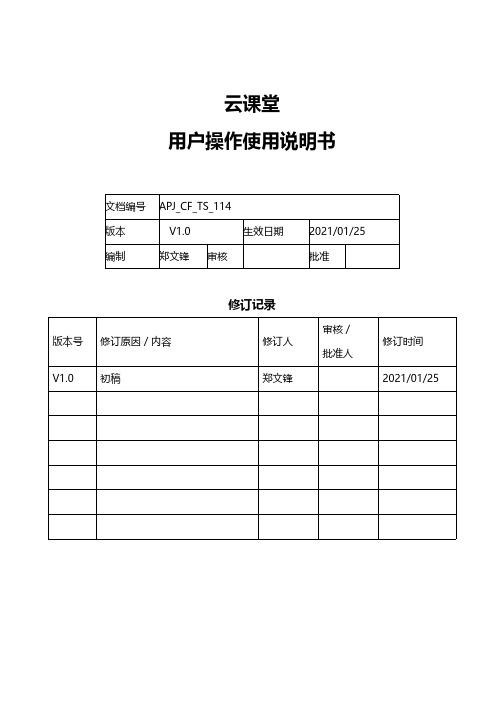
云课堂用户操作使用说明书文档编号APJ_CF_TS_114版本V1.0生效日期2021/01/25编制郑文锋审核批准修订记录版本号修订原因/内容修订人审核/批准人修订时间V1.0初稿郑文锋2021/01/25目录一、引言 (5)1.系统概述 (5)2.定义 (5)3.总体流程 (6)二、功能模块 (7)1.管理端 (7)2.移动学习端 (8)三、功能使用说明 (9)1.管理端 (9)1.1.功能列表 (9)1.2.首页装修(1-1) (10)1.3.课程分类(1-2) (13)1.4.店铺设置(1-3) (15)1.5.素材管理(2-1) (15)1.6.图文课程(2-2) (17)1.7.视频课程(2-3) (18)1.8.音频课程(2-4) (20)1.9.电子书(2-5) (22)1.10.品牌课程(2-6) (24)1.11.专栏课程(2-7) (26)1.12.直播课程管理(3-1) (29)1.13.在线直播上课(3-2) (30)1.14.培训计划(4-1) (31)1.15.组织活动(4-2) (35)1.16.训练营(4-3) (37)1.17.本月课表(5-1) (37)1.18.试卷管理(5-2) (38)1.19.题库管理(5-3) (40)1.20.问卷管理(5-4) (41)1.21.证书管理(5-5) (42)1.22.作业管理(5-6) (42)1.23.课程分析(6-1) (43)1.24.学习分析(6-2) (43)1.25.学员分析(6-3) (43)1.26.学员管理(7-1) (43)1.27.角色管理(7-2) (43)1.28.账户管理(7-3) (43)1.29.系统消息(7-4) (44)2.移动学习端 (44)2.1.功能列表 (44)2.2.专属首页(1-1~1-4) (46)2.3.在学(2-1~2-5) (47)2.4.交流(3-1~3-3) (48)2.5.发起交流(3-4) (49)2.6.图文课程(4-1) (49)2.7.视频课程(4-2) (52)2.8.音频课程(4-3) (55)2.9.电子书(4-4) (56)2.10.品牌课程(4-5) (58)2.11.专栏课程(4-6) (59)2.12.直播课程(4-7) (63)2.13.计划课程(5-1) (65)2.14.报名参与(6-1) (66)2.15.签到(6-2) (67)2.16.参加考试(7-1) (68)2.17.填写问卷(7-2) (76)2.18.提交作业(7-3)...............................................................................错误!未定义书签。
思科统一通信自助服务门户网站用户指南说明书

Cisco Unified Communications Self Care 门户网站用户指南 10.5(1) 版Unified Communications Self Care门户网站2Unified Communications Self Care设置2电话4附加设置12Revised: January 22, 2015, OL-32117-01Unified Communications Self Care 门户网站本文档说明如何使用Unified Communications Self-Care门户网站配置Cisco Unified IP电话和Jabber应用程序的用户设置。
使用Unified Communications Self Care门户网站可以配置各项设置,例如快速拨号号码、联系人列表、电话服务和语音信箱通知。
本文档包含以下各节:Unified Communications Self Care 设置本用户指南说明Unified Communications Self-Care Portal中所有可用的配置设置。
本指南假定您的电话支持所有可用的设置,并且网络管理员已配置Unified Communications Self-Care Portal显示所有用户设置。
请注意,当您在Unified Communications Self-Care Portal中设置电话时,本指南中出现的某些设置可能不会显示,原因如下:•电话功能 如果某项功能不适用于您的特定电话型号,则当您在Unified Communications Self-Care Portal中设置电话时,该功能不会出现。
例如,如果您的电话不支持“免打扰”,则该功能不会显示为可用的设置。
•企业参数 网络管理员可以在Cisco Unified Communications Manager中设置企业参数,以限制用户可以在Unified Communications Self-Care Portal中配置的设置。
云·企业官网用户手册说明书

在接到通知 的 1 个 作日内反馈 网站 作的每一 完 ,系统都会发
短信 邮
消息通知,您 以在网站 预 效果,进行确认或回复修改
意见
3.1 确认需求
云·企业官网用户手册
1 准备网站资料 公 LOGO 公 介绍 产品及新闻介绍
参考网站等
2 登录网站
阿云
登录,或在 ac
登录
l 阿 云登录 使用阿 云账 登录阿 云官网 ,
港节点均有部署 按相关法律法规 内网站 须备案
才 以使用,请杭
州节点用户在业 开通 立刻 交网站备案 参见业 开通流程中的备案说
明 ,以免影响网站 线使用 香港节点 于海外无需备案,适合全球 问,Байду номын сангаас
但 内用户 能会因 法问
网络链路或 策因素
云·企业官网用户手册
网站打开缓慢甚 阶段性无
2 业 开通
2.1 购 开通
域 绑定与解析 网站发布
网站运营与维护 .................................................................................................... 8
网站推广 E 设置 修改或添 页面 添 产品 文章
添 产品 添 文章 实现网站 H
à通信管理局 à备案
通常 备案初 到备案 预 时间 15-20
个 作日 各地通信管理局 时间
1) 使用阿 云账 登录阿 云备案系统 ,点 开始备案
2) 填写备案信息 交阿 云初
云·企业官网用户手册
云·企业官网用户手册
云·企业官网用户手册
云·企业官网用户手册
其它 .........................................................................................................................
新网互联基础业务业务操作手册

新网互联基础业务业务操作手册1. 登录云服务器控制台首先,在浏览器中输入云服务器的管理地址,然后输入正确的用户名和密码登录云服务器控制台。
2. 创建云服务器登录云服务器控制台后,点击"创建云服务器"按钮,根据需求选择云服务器的规格、地域、镜像等,并设置登录密码和安全组规则。
3. 启动云服务器在云服务器列表中找到需要启动的云服务器,点击"启动"按钮,等待云服务器启动完成。
4. 连接云服务器启动云服务器后,可以点击"连接"按钮,通过远程桌面软件或SSH工具连接到云服务器。
5. 配置云服务器连接到云服务器后,可以进行一些基本配置,比如安装所需的软件、配置网络和防火墙等。
6. 监控和管理云服务器在云服务器控制台中,可以查看云服务器的实时监控数据和使用情况,也可以进行云服务器的管理操作,比如重启、停止和删除等。
二、云存储管理云存储管理是新网互联的另一个基础业务,下面将介绍云存储的管理操作流程。
1. 登录云存储控制台在浏览器中输入云存储的管理地址,然后输入正确的用户名和密码登录云存储控制台。
2. 创建存储桶登录云存储控制台后,点击"创建存储桶"按钮,输入存储桶的名称和所在地域,并设置访问权限和存储类型等。
3. 上传文件在存储桶列表中找到需要上传文件的存储桶,点击"上传文件"按钮,选择要上传的文件并设置文件的访问权限。
4. 下载文件在存储桶中找到需要下载的文件,点击文件名或右键点击文件并选择"下载"选项。
5. 删除文件在存储桶中找到需要删除的文件,点击文件名或右键点击文件并选择"删除"选项,然后确认删除操作。
6. 设置生命周期规则在存储桶的管理页面中,可以设置生命周期规则,自动删除或转换存储类型等。
三、云数据库管理云数据库管理是新网互联的另一个基础业务,下面将介绍云数据库的管理操作流程。
云计算平台使用说明书

云计算平台使用说明书1.简介云计算平台是一种基于云技术的计算资源管理和分配系统,旨在提供灵活、可扩展的计算资源和服务。
本使用说明书将详细介绍云计算平台的功能和操作方法,帮助用户快速上手并充分利用平台提供的各项服务。
2.注册与登录在使用云计算平台之前,用户需要注册一个账号。
请访问平台官方网站,在注册页面填写必要的个人信息并完成注册。
注册成功后,用户可以使用注册时设定的用户名和密码登录平台。
3.用户界面登录云计算平台后,用户将进入主界面。
主界面分为三个核心部分:导航栏、信息区域和操作区域。
- 导航栏:位于页面的顶部,包含各个功能模块的入口链接,如虚拟机管理、存储管理、网络管理等。
- 信息区域:位于页面的左侧或右侧,显示用户的基本信息和当前所选择的功能模块的详细信息。
- 操作区域:位于页面的中央或右侧,提供用户进行各种操作的按钮和表单。
4.虚拟机管理云计算平台提供了强大的虚拟机管理功能,用户可以根据自身需求创建、启动、停止、删除虚拟机等操作。
以下是虚拟机管理的基本流程:- 创建虚拟机:选择合适的配置参数,如CPU核数、内存大小、硬盘容量等,填写虚拟机名称并点击创建按钮。
- 启动虚拟机:选择已创建的虚拟机,点击启动按钮即可启动虚拟机。
- 停止虚拟机:选择已启动的虚拟机,点击停止按钮即可停止虚拟机。
停止后虚拟机的运行状态将变为“已停止”。
- 删除虚拟机:选择已停止的虚拟机,点击删除按钮即可删除虚拟机。
删除后虚拟机及其相关数据将无法恢复,请谨慎操作。
5.存储管理云计算平台提供了灵活的存储管理功能,用户可以创建、删除、扩容存储卷,并对存储卷进行备份、恢复等操作。
以下是存储管理的基本流程:- 创建存储卷:选择存储卷类型,填写存储卷名称和大小,点击创建按钮即可创建存储卷。
- 删除存储卷:选择已创建的存储卷,点击删除按钮即可删除存储卷。
删除前请确保存储卷中的数据已备份或不再需要。
- 扩容存储卷:选择已创建的存储卷,点击扩容按钮,填写扩容大小并确认操作。
云计算平台的使用教程及业务弹性优化

云计算平台的使用教程及业务弹性优化云计算是指将计算机资源组织起来,通过网络进行交互和分享的一种计算模式。
云计算平台作为一种基于互联网的计算模式,为用户提供弹性的IT资源和服务,成为许多企业进行业务开展的首选。
本文将介绍云计算平台的使用教程,并探讨如何优化业务的弹性。
一、云计算平台的使用教程1. 注册和登录首先,用户需要在云计算平台上进行注册。
通过提供所需的个人信息,填写用户名和密码,并完成邮箱或手机验证,用户即可成功注册。
接下来,用户可以使用注册时设置的用户名和密码登录到云计算平台。
2. 创建云主机登录成功后,用户可以创建自己的云主机实例。
云主机是云计算平台上运行的虚拟机,提供计算资源和操作系统等功能。
用户需要选择云主机的规格、存储、网络等参数,并设置登录密码或密钥。
点击创建,系统将自动分配虚拟机资源并启动云主机实例。
3. 配置网络在云计算平台上,用户可以创建自己的网络。
用户可以设置虚拟网络的IP地址范围、子网、路由器等网络参数。
此外,用户还可以创建安全组来限制云主机的访问权限,确保网络的安全性。
4. 存储和备份云计算平台提供了丰富的存储和备份选项。
用户可以选择将数据存储在对象存储系统中,实现数据的持久化存储。
同时,用户还可以配置自动备份策略,确保数据的安全性和可靠性。
5. 监控和管理云计算平台提供了强大的监控和管理工具,帮助用户实时监控云主机和其他资源的使用情况。
用户可以查看云主机的CPU、内存、网络等性能指标,并根据监控结果进行优化和调整。
二、业务弹性优化1. 弹性计算资源云计算平台的弹性计算资源使得用户可以根据业务需求灵活地进行扩容或缩减。
当业务需求增加时,用户可以通过增加云主机实例的数量或调整云主机的规格来扩展计算资源。
反之,当业务需求减少时,用户可以减少云主机实例的数量或调整云主机的规格来缩减计算资源,节省成本。
2. 自动负载均衡云计算平台的自动负载均衡可以将用户的业务流量均衡地分布到多个云主机实例中,以实现更好的响应速度和可靠性。
云平台用户操作手册
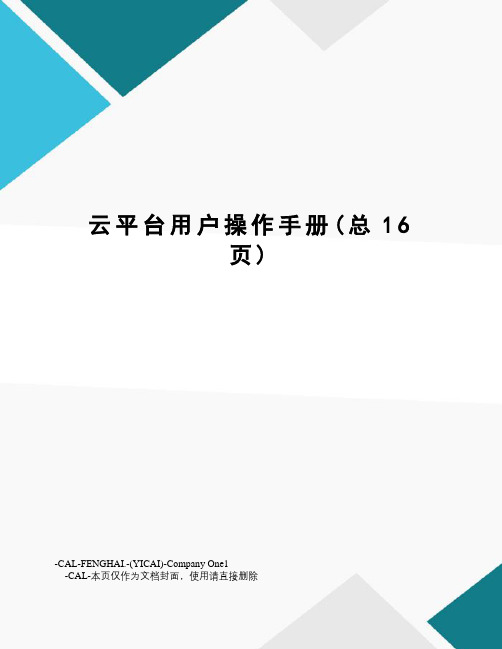
云平台用户操作手册(总16页)-CAL-FENGHAI.-(YICAI)-Company One1-CAL-本页仅作为文档封面,使用请直接删除云计算管理平台用户操作手册文档日期:2015年7月20日文档版本:<V1.0>关于本文档目录目录 (3)1. 准备工作 (5)1.1 基础知识 (5)............................................................................................................ 错误!未定义书签。
............................................................................................................ 错误!未定义书签。
............................................................................................................ 错误!未定义书签。
1.2系统统一规则 (6)1.3工作界面介绍 (6)2. 登录与统一权限管理 (7)2.1登录与退出 (7)............................................................................................................ 错误!未定义书签。
............................................................................................................ 错误!未定义书签。
3. 云门户 (8)3.1云中心概览 (8)3.2资源使用情况 (9)3.3最近活动 (9)3.4资源机构分配情况 (9)3.5告警分布 (9)3.6应用使用情况 (9)4. 我的云中心 (9)4.1待办事项 (9)4.2已办事项 (10)4.3我的申请 (10)4.4我的虚拟机 (10)4.5我的资源池 (11)4.6任务活动 (11)4.7事件告警 (11)4.8账户设置 (12)4.9系统通知 (12)5. 服务目录 (12)5.1创建虚拟机 (12)5.2创建资源池 (12)6. 应用管理 (13)6.1应用管理 (13)7. 健康中心 (14)7.1实时告警 (14)7.2告警配置 (14)7.3主机监控 (14)7.4虚拟机监控 (15)8.基础设施 (15)8.1资源管理中心 (15)8.2虚拟机创建策略 (15)8.3模板配置 (16)9.系统管理 (17)9.1机构管理 (17)9.2人员管理 (18)9.3角色管理 (19)10.基本工作流程 (20)10.1初次登录 (20)10.2审批流程说明 (20)1.准备工作1.1 基础知识为使语言表述简洁,本书使用了一些标准的计算机操作说明术语。
思普瑞视频会议平台使用手册
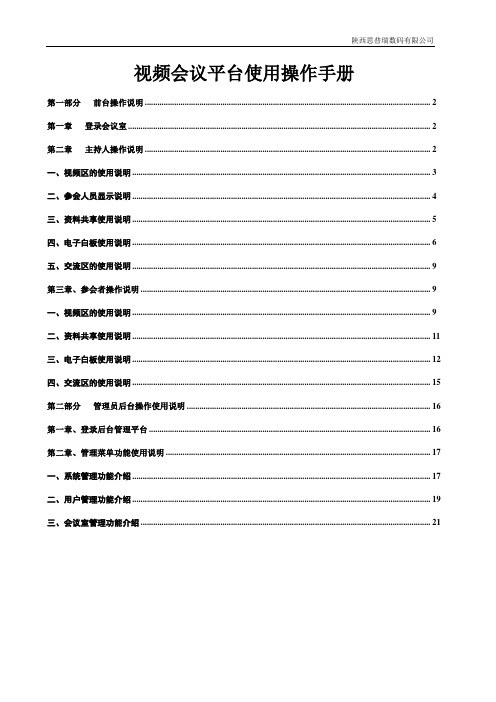
视频会议平台使用操作手册第一部分前台操作说明 (2)第一章登录会议室 (2)第二章主持人操作说明 (2)一、视频区的使用说明 (3)二、参会人员显示说明 (4)三、资料共享使用说明 (5)四、电子白板使用说明 (6)五、交流区的使用说明 (9)第三章、参会者操作说明 (9)一、视频区的使用说明 (9)二、资料共享使用说明 (11)三、电子白板使用说明 (12)四、交流区的使用说明 (15)第二部分管理员后台操作使用说明 (16)第一章、登录后台管理平台 (16)第二章、管理菜单功能使用说明 (17)一、系统管理功能介绍 (17)二、用户管理功能介绍 (19)三、会议室管理功能介绍 (21)第一部分前台操作说明第一章登录会议室选择视频会议室,参加会议的选择会议室,测试的选择测试会议室。
输入用户名和密码,测试会议室点击测试帐号,选择身份登录(包括主持人和参会者两种)进入会议室。
进入会议室,显示界面如下:进入会议室,交流区会显示该会议室的会议公告,公告内容可以在后台里面设置。
第二章主持人操作说明一、视频区的使用说明视频窗口从上到下依次显示为:当前发言人员视频、主持人视频和本地视频窗口。
在视频窗口的上方会显示网络连接状态,为节省带宽,可以选择节省带宽模式,此时仅保留音频。
在进入会议室的时候,点击视频下方的可以切换为,用来选择是否打开视频。
点击视频下方的可以切换为,用来选择该会议室是否允许自动发言。
主持人选择允许自动发言后,参会人员可以直接选择“举手发言”发表自己的看法;取消自动发言之后,参会人员点击“举手发言”之后,需要主持人在里选择允许该参会人员发言。
发言人员的视频会显示在当前发言人员视频窗口里面。
点击视频下方的可以切换为,用来选择会议室的模式。
★当前发言人员视频在当前发言人员视频窗口左上方会显示可以按比例调整视频窗口的大小;视频窗口左上方会显示可以选择是否接受该发言人员的视频和音频。
为节省带宽,可以选择在不需要的时候,关闭视频。
JL-20T MPRO 工业联网精灵用户使用手册说明书
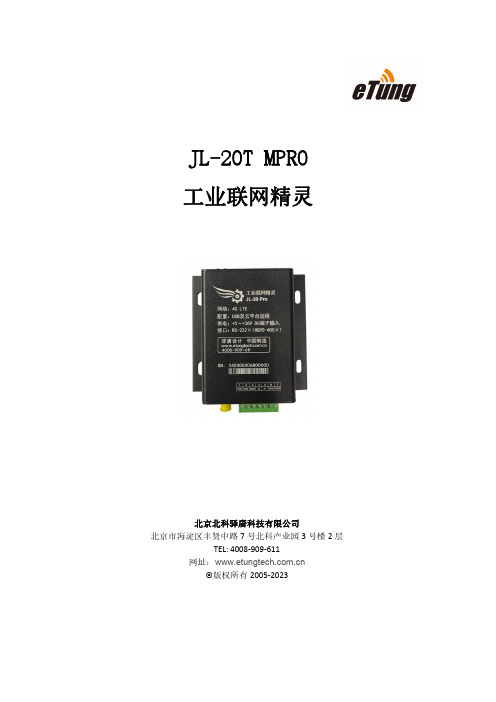
JL-20T MPRO工业联网精灵北京北科驿唐科技有限公司北京市海淀区丰贤中路7号北科产业园3号楼2层TEL:4008-909-611网址:©版权所有2005-2023目录第一章产品介绍 (3)1.1产品简介 (3)1.2产品外观 (4)1.3标准配件 (5)1.4安装尺寸 (6)1.5规格参数 (7)1.5.1技术参数 (7)1.5.2指示灯说明 (8)1.5.3接线端子定义 (8)1.6工作原理 (9)第二章设备配置 (10)2.1.申请账户 (10)2.2.添加BOX (10)2.3.配置通讯口 (11)2.4.添加变量 (12)2.5.添加报警 (13)2.6.配置下载至BOX (14)2.7.新建项目 (15)2.8.项目绑定BOX (15)2.9.云平台监控数据 (16)2.10.模块防拆 (17)2.11.更新固件 (19)第三章设备驱动说明 (24)3.1ModbusRTU (24)3.1.1概述 (24)3.1.2前期准备工作: (24)3.1.3设备设置 (24)3.1.3.1硬件连接 (24)3.1.3.2JL-20T MPRO设置 (25)3.1.3.3从设备设置 (25)3.1.4变量地址说明 (26)3.1.5台达PLC从设备设置 (26)3.1.6信捷PLC从设备设置 (29)3.1.7上电科PLC从设备设置 (29)附录1:使用JL-20T MPRO实现串口设备的远程程序更新案例 (31)1.在串口通软件中添加终端 (31)2.在串口通软件中下发远程AT命令停止MODBUS数据采集 (32)3.在串口通软件中设置串口参数 (33)4.在串口通软件中给联网宝映射虚拟串口 (34)5.使用设备编程软件选择虚拟串口通信 (36)6.在串口通软件中下发远程AT命令恢复MODBUS数据采集 (36)第一章产品介绍本章主要介绍JL-20T MPRO的外观、配件、规格参数和使用原理。
PLC-507工业联网宝使用手册说明书

PLC-507工业联网宝使用手册北京北科驿唐科技有限公司北京市海淀区丰贤中路7号北科产业园3号楼2层TEL:4008-909-611网址:©版权所有2005-2023本手册适用于如下型号:型号说明PLC-507-W0支持WIFI及WAN有线网络,默认使用WAN有线网络PLC-507-W4支持4G/3G/2G无线网络和WIFI/WAN网络,默认使用WAN有线网络目录第一章产品介绍 (3)1.1产品简介 (3)1.2产品外观 (4)1.3标准配件 (5)1.4安装尺寸 (6)1.5工作原理 (7)1.6规格参数 (8)1.6.1技术参数 (8)1.6.2指示灯说明 (9)1.6.3串口定义 (10)1.6.4RESET按钮 (10)1.7典型应用 (11)第二章设备配置 (13)2.1配置方法 (13)2.1.1准备工作 (13)2.1.2配置PLC-507 (13)2.2配置参数介绍 (20)2.3恢复出厂设置 (22)2.4固件更新 (22)2.5远程配置 (24)附录1:PLC-507网口通功能实现PLC远程程序更新案例 (28)1.注册驿云账号 (28)2.配置PLC-507 (29)3.设置网口通软件 (29)4.通过网口通远程访问PLC-507配置界面 (33)附录2:PLC-507串口功能实现PLC远程程序更新案例 (37)1.注册联网宝驿云账号 (37)2.配置PLC-507 (38)3.配置串口通软件 (39)附录3:配置PLC-507通过4G无线网络上网 (42)附录4:配置PLC-507通过有线/WIFI接入网络 (43)附录5:用PLC-507网口收发短信及短信数据格式 (53)附录6:PLC-507结合VNC软件实现设备远程控制 (57)附录7:网口通结合工业联网宝虚网映射功能实现下位机设备相同IP地址的远程访问 (64)附录8:设置电脑/网口设备通过联网宝上网 (68)附录9:工业联网宝MODBUS TCP接口说明 (72)附录10:工业联网宝DMZ转发增强功能 (73)第一章产品介绍本章主要介绍PLC-507的外观、配件、规格参数和使用原理。
云平台操作手册46页PPT

46、法律有权打破平静。——马·格林 47、在一千磅法律里,没有一盎司仁 爱。— —英国
48、法律一多,公正就少。——托·富 勒 49、犯罪总是以惩罚相补偿;只有处 罚才能 使犯罪 得到偿 还。— —达雷 尔
50、弱者比强者更能得到法律的保护 。—— 威·厄尔
61、奢侈是舒适的,否则就不是奢侈 。——CocoCha nel 62、少而好学,如日出之阳;壮而好学 ,如日 中之光 ;志而 好学, 如炳烛 之光。 ——刘 向 63、三军可夺帅也,匹夫不可夺志也。 ——孔 丘 64、人生就是学校。在那里,与其说好 的教师 是幸福 ,不如 说好的 教师是 不幸。 ——海 贝尔 65、接受挑战,就可以享受胜利的喜悦 。——杰纳勒 尔·乔治·S·巴顿
谢谢!
sinoep工作流用户手册.doc
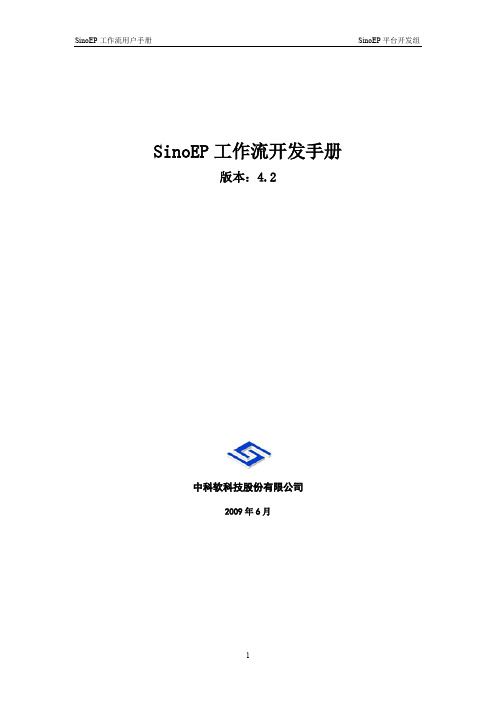
SinoEP工作流开发手册版本:4.2中科软科技股份有限公司2009年6月1. 阅读指南 (4)1.1. 手册目标 (4)1.2. 阅读对象 (4)1.3. 手册约定 (4)2. 体系介绍 (4)3. 流程定义 (4)3.1. 定义工具配置文件 (4)3.1.1. workflow.xml (5)3.2. 流程定义工具需要实现的接口 (5)3.3. 流程配置过程 (8)3.3.1. 打开配置界面 (8)3.3.2. 初始化数据 (9)3.3.3. 新建流程 (18)3.3.4. 配置流程 (24)4. 工作流引擎 (44)4.1. 引擎配置文件 (44)4.1.1. oscache.properties (44)4.1.2. workflow.xml (45)4.2. 引擎需要实现的接口 (45)4.2.1. 数据操作的接口 (45)4.2.2. 组织机构接口 (48)4.2.3. 逾期实现接口 (52)4.2.4. 应用程序实现接口 (52)4.2.5. 办理人设置实现接口 (53)4.3. 启动工作流 (53)4.3.1. 工作流引擎入口参数 (53)4.3.2. Servlet和方法启动工作流 (54)4.4. 处理待办和已办 (55)4.4.1. 打开待办页面 (55)4.4.2. 打开待办页面一般需要调用的接口 (56)4.4.3. 如何打开已办页面 (56)4.4.4. 打开已办页面一般需要调用的接口 (56)4.5. 数据封装类 (56)4.5.1. 文件类型FlowFileTypeVO (57)4.5.2. 流程FlowWorkflowVO (57)4.5.3. 待办FlowWriteVO (57)4.5.4. 已办FlowReadVO (58)4.5.5. 实例FlowWorkflowinfoVO (59)4.5.6. 流转日志FlowWflogVO (60)4.5.7. 意见FlowIdeaVO (61)4.5.8. 签名FlowSignVO (62)4.6. 引擎提供的接口 (62)4.6.1. 取待办 (62)4.6.2. 取已办 (65)4.6.3. 待办已办提示信息 (66)4.6.4. 有关意见操作的接口 (70)4.6.5. 存取临时签名 (73)4.6.6. 签收 (74)4.6.7. 有关按钮操作的接口 (75)4.6.8. 业务表单的权限控制 (76)4.6.9. 收回操作的控制 (77)4.6.10. 有关待办授权和工作移交的操作的接口 (83)4.6.11. 修改流程状态的接口 (85)resumeFlow(String fileTypeId,String recordId) (85)4.6.12. 得到当前用户有启动权限的流程 (88)4.6.13. 其它 (89)5.7工作流控制公式 (90)1.阅读指南1.1. 手册目标本手册主要面向使用工作流产品进行二次开发的开发人员及部分工作流产品的最终用户撰写。
- 1、下载文档前请自行甄别文档内容的完整性,平台不提供额外的编辑、内容补充、找答案等附加服务。
- 2、"仅部分预览"的文档,不可在线预览部分如存在完整性等问题,可反馈申请退款(可完整预览的文档不适用该条件!)。
- 3、如文档侵犯您的权益,请联系客服反馈,我们会尽快为您处理(人工客服工作时间:9:00-18:30)。
Байду номын сангаас思普云平台操作手册
(版本:V1.7.1)
湖南华辰智通科技有限公司 2019 年 07 月
思普云平台操作手册
目录
1. 引言............................................................................................................................................... 1 1.1. 简介................................................................................................................................... 1 1.2. 编写目的...........................................................................................................................1 1.3. 项目背景...........................................................................................................................1 1.3.1. 工业物联网的发展现状.......................................................................................1 1.3.2. 工业物联网的发展需求.......................................................................................1 1.3.3. 工业物联网的发展意义.......................................................................................2 1.4. 参考资料...........................................................................................................................2
